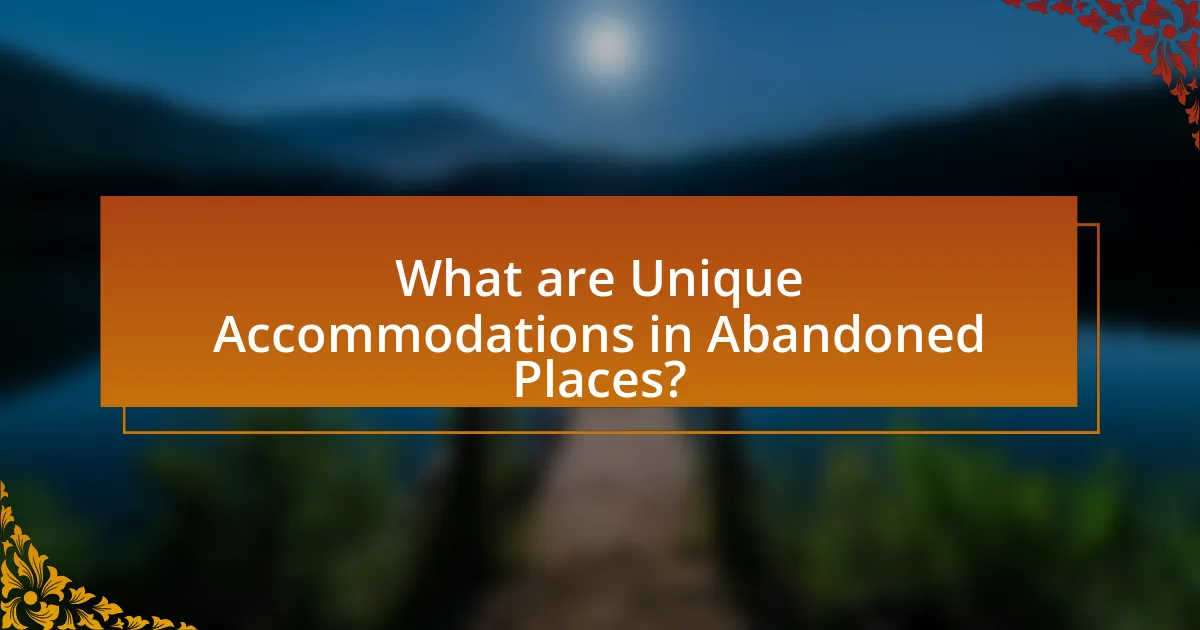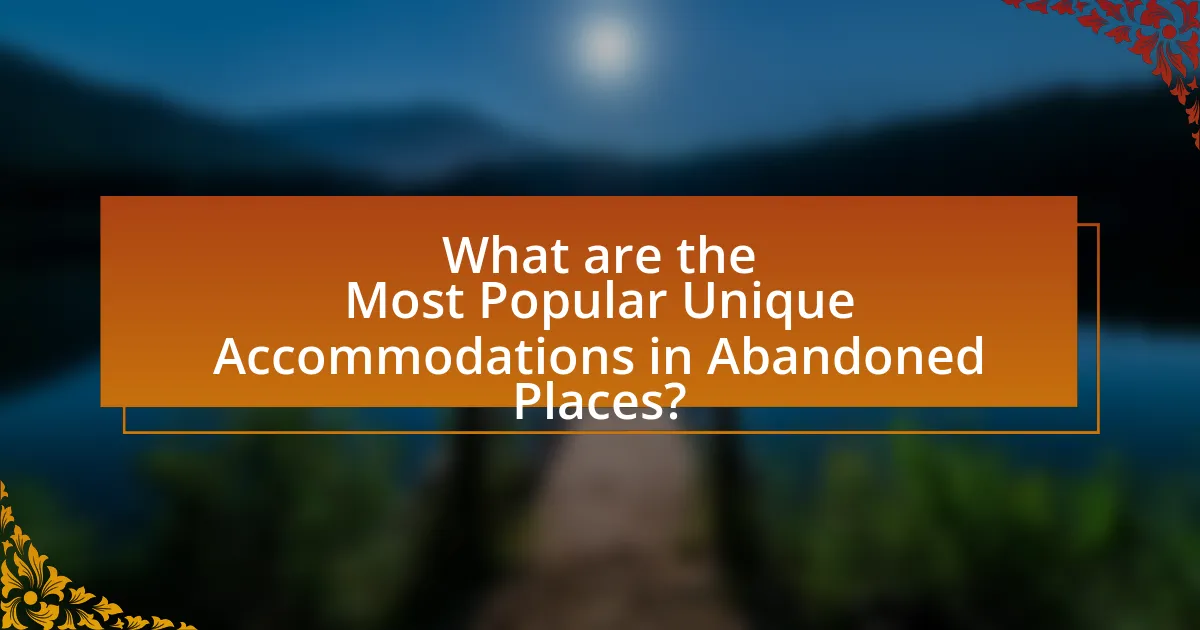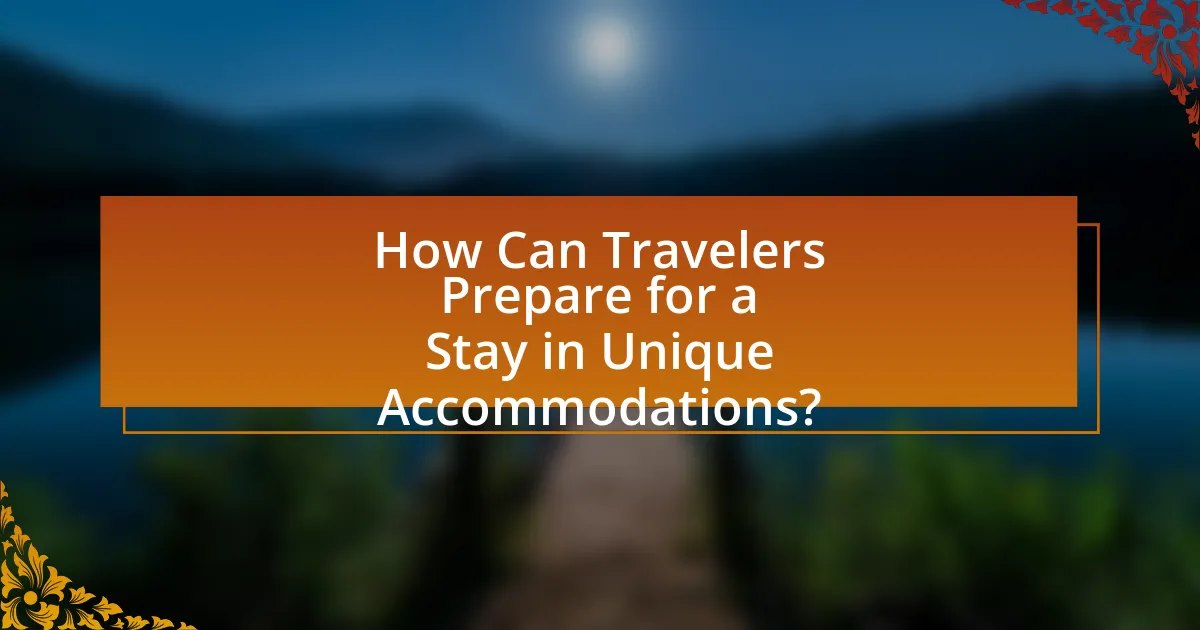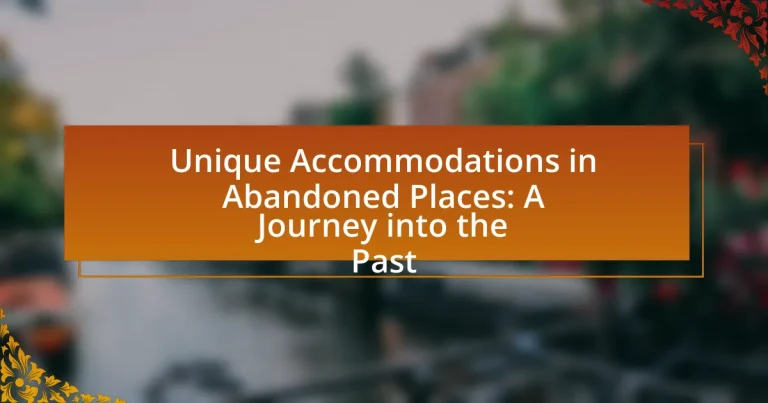Unique accommodations in abandoned places offer travelers a distinctive blend of history and modern comfort by repurposing structures such as factories, hotels, and schools into lodgings. These accommodations provide guests with immersive experiences that highlight the historical significance of the locations, often featuring original architectural elements. The article explores the types of abandoned places commonly transformed into accommodations, the appeal of these unique experiences, and the challenges associated with staying in such settings. Additionally, it discusses how social media promotes these experiences and outlines best practices for travelers to ensure a safe and enjoyable stay.

What are Unique Accommodations in Abandoned Places?
Unique accommodations in abandoned places include repurposed structures such as old factories, hotels, and schools transformed into lodgings. These unique stays often feature original architectural elements, providing guests with a blend of history and modern comfort. For example, the Hotel del Salto in Colombia, once a luxury hotel, now offers rooms with views of the Tequendama Falls, showcasing its historical significance and natural beauty. Similarly, the Abandoned Prison Hotel in Lithuania allows visitors to experience life in a former prison while enjoying contemporary amenities. Such accommodations attract travelers seeking adventure and a connection to the past, highlighting the growing trend of adaptive reuse in the hospitality industry.
How do these accommodations differ from traditional lodging options?
Unique accommodations in abandoned places differ from traditional lodging options primarily in their historical and experiential value. These accommodations often provide guests with a unique opportunity to stay in locations that have significant historical context, such as repurposed factories, schools, or hotels, which contrasts with traditional lodging that typically focuses on modern amenities and uniformity. For example, staying in a renovated lighthouse or an old train station allows guests to engage with the past in a way that standard hotels do not offer, enhancing the overall travel experience. This distinctive aspect attracts travelers seeking adventure and a deeper connection to the history of the location, setting them apart from conventional lodging options that prioritize comfort and convenience over historical significance.
What types of abandoned places are commonly transformed into accommodations?
Commonly transformed abandoned places into accommodations include old factories, schools, churches, and railway stations. These structures often possess unique architectural features and historical significance, making them attractive for conversion into hotels, hostels, or vacation rentals. For instance, the conversion of the former St. Pancras railway station in London into a luxury hotel showcases how such spaces can be repurposed while preserving their historical essence. Additionally, repurposed factories, like the Hotel des Arts in San Francisco, highlight the trend of transforming industrial spaces into modern living environments.
Why do travelers seek out these unique experiences?
Travelers seek out unique experiences in abandoned places to connect with history and explore the stories behind these locations. Engaging with abandoned sites allows individuals to experience a sense of adventure and curiosity, as they often provide a glimpse into the past that is both intriguing and thought-provoking. Research indicates that immersive experiences, such as visiting unique accommodations in historical settings, enhance emotional engagement and personal reflection, making these journeys memorable. According to a study published in the Journal of Travel Research, 70% of travelers prioritize unique experiences over traditional tourism, highlighting the growing demand for such adventures.
What historical significance do these abandoned places hold?
Abandoned places hold significant historical value as they often represent the remnants of past societies, cultures, and economies. These sites can provide insights into architectural styles, technological advancements, and social dynamics of the time they were active. For example, the abandoned mining towns in the American West illustrate the boom-and-bust cycles of resource extraction and settlement patterns in the 19th century. Additionally, structures like the Chernobyl Exclusion Zone serve as stark reminders of historical events, such as the nuclear disaster of 1986, highlighting the impact of human error and environmental consequences. Such locations not only preserve artifacts of daily life but also evoke narratives of resilience, decline, and transformation within communities.
How can the history of a location enhance the guest experience?
The history of a location can significantly enhance the guest experience by providing a rich narrative that connects visitors to the past. When guests stay in unique accommodations within abandoned places, they often encounter stories of the site’s original purpose, its cultural significance, and the people who once inhabited it. For example, a former factory turned into a hotel may offer insights into the industrial history of the area, allowing guests to appreciate the transformation of the space and its historical context. This connection to history can evoke emotions, stimulate curiosity, and create memorable experiences, as guests engage with the remnants of the past, fostering a deeper understanding of the location’s heritage.
What stories do these abandoned places tell about the past?
Abandoned places tell stories of human endeavor, societal change, and historical events. These locations often reflect the economic conditions, cultural shifts, and technological advancements of their time. For instance, the ruins of a once-thriving factory may illustrate the rise and fall of industrialization, while deserted towns can reveal the impact of migration and urbanization. Specific examples include the Chernobyl Exclusion Zone, which narrates the consequences of nuclear disaster, and the ghost towns of the American West, which highlight the boom and bust cycles of mining and settlement. Each abandoned site serves as a tangible reminder of the lives once lived there, encapsulating the hopes, struggles, and transformations of past communities.
What are the challenges of staying in abandoned accommodations?
Staying in abandoned accommodations presents several challenges, including safety hazards, legal issues, and lack of amenities. Safety hazards often arise from structural instability, exposure to hazardous materials like asbestos, and the presence of wildlife or pests. Legal issues can stem from trespassing laws, as many abandoned properties are privately owned, leading to potential fines or legal action. Additionally, the lack of basic amenities such as running water, electricity, and sanitation facilities can significantly impact comfort and health. These factors collectively make staying in abandoned accommodations risky and uncomfortable.
How do safety concerns impact the design of these accommodations?
Safety concerns significantly influence the design of accommodations in abandoned places by necessitating structural integrity and risk mitigation measures. Designers must assess potential hazards such as unstable buildings, hazardous materials, and environmental risks, leading to the incorporation of reinforced structures, secure access points, and safety equipment. For instance, the use of modern materials and engineering techniques can enhance the durability of these accommodations, ensuring they can withstand weather conditions and prevent accidents. Additionally, safety regulations often require clear evacuation routes and emergency protocols, which further shape the layout and functionality of these unique spaces.
What measures are taken to ensure guest comfort and security?
To ensure guest comfort and security in unique accommodations located in abandoned places, operators implement several key measures. These measures typically include thorough safety inspections of the premises to identify and mitigate potential hazards, such as structural weaknesses or environmental risks. Additionally, accommodations often provide modern amenities like heating, air conditioning, and secure locking systems to enhance guest comfort and safety.
Furthermore, staff training in emergency procedures and first aid is common, ensuring that guests receive immediate assistance if needed. Surveillance systems may also be installed to monitor the property, adding an extra layer of security. These practices are essential for creating a safe and enjoyable experience for guests in unconventional settings.
How do unique accommodations in abandoned places attract visitors?
Unique accommodations in abandoned places attract visitors by offering a distinctive blend of nostalgia, adventure, and the allure of the unknown. These settings provide an immersive experience that allows guests to connect with history and explore the remnants of past civilizations. For instance, accommodations in repurposed factories or old hotels often feature original architectural elements, which enhance the aesthetic appeal and create a unique atmosphere. Additionally, the novelty of staying in a location with a storied past can evoke curiosity and excitement, drawing in those seeking unconventional travel experiences. Statistics indicate that experiential travel, which includes unique stays, has seen a significant rise, with 72% of travelers expressing interest in unique lodging options, highlighting the demand for such experiences.
What role does social media play in promoting these experiences?
Social media plays a crucial role in promoting unique accommodations in abandoned places by providing a platform for visual storytelling and community engagement. Through platforms like Instagram and Facebook, users share captivating images and experiences, which generate interest and awareness about these unconventional stays. For instance, a study by the Pew Research Center found that 72% of adults use social media, making it an effective tool for reaching a broad audience. Additionally, hashtags related to abandoned places often trend, further amplifying visibility and attracting potential visitors. This organic sharing creates a sense of authenticity and curiosity, driving tourism to these unique locations.

What are the Most Popular Unique Accommodations in Abandoned Places?
The most popular unique accommodations in abandoned places include repurposed hotels, old prisons, and decommissioned military bases. For instance, the Hotel del Salto in Colombia, once a luxurious retreat, now offers a unique experience overlooking a waterfall. Similarly, the Alcatraz Island in San Francisco allows visitors to stay overnight in a former prison, providing a historical perspective. Additionally, the Krampnitz Barracks in Germany, a former military base, has been transformed into a unique lodging option, attracting those interested in history and urban exploration. These accommodations not only provide a place to stay but also immerse guests in the rich narratives of their pasts.
Which abandoned places have been successfully converted into accommodations?
Several abandoned places have been successfully converted into accommodations, including the Hotel del Salto in Colombia, which was transformed from a derelict mansion into a boutique hotel, and the Abandoned Prison Hotel in Lithuania, which offers unique lodging experiences in a former prison. Additionally, the Parador de Cangas de Onís in Spain was once a monastery before being repurposed into a hotel, showcasing historical architecture while providing modern amenities. These conversions not only preserve the historical significance of the structures but also attract tourists seeking unique lodging experiences.
What features make these locations particularly appealing to guests?
Unique accommodations in abandoned places appeal to guests due to their distinctive historical charm and immersive experiences. These locations often feature original architecture, which provides a glimpse into the past, allowing guests to connect with history in a tangible way. Additionally, the novelty of staying in a repurposed space, such as an old factory or a deserted hotel, creates a sense of adventure and curiosity. Many of these sites are situated in picturesque or remote settings, enhancing the allure with natural beauty and tranquility. The combination of unique aesthetics, historical significance, and the opportunity for exploration makes these accommodations particularly attractive to guests.
How do these accommodations reflect the culture of their surroundings?
Accommodations in abandoned places reflect the culture of their surroundings by embodying the architectural styles, materials, and historical significance of the local community. For instance, a repurposed factory in an industrial area may retain original brickwork and machinery, showcasing the region’s industrial heritage and craftsmanship. Additionally, the design elements, such as local art or traditional furnishings, often highlight cultural practices and social values, providing insight into the lifestyle and history of the inhabitants. This connection between the accommodations and their environment illustrates how the past influences contemporary interpretations of space and community identity.
What are some notable examples of unique accommodations worldwide?
Notable examples of unique accommodations worldwide include the Icehotel in Sweden, which is constructed entirely of ice and snow and rebuilt annually, and the Treehotel in Sweden, featuring treehouses designed by different architects. Additionally, the Giraffe Manor in Kenya allows guests to interact with resident giraffes, while the Propeller Island City Lodge in Germany offers individually themed rooms that challenge conventional hotel design. These accommodations stand out due to their distinctive features and immersive experiences, attracting travelers seeking something beyond traditional lodging.
How do these examples differ in terms of design and experience?
The examples of unique accommodations in abandoned places differ significantly in design and experience. For instance, one accommodation may feature a rustic, industrial aesthetic with exposed brick and metal elements, creating a raw, authentic atmosphere, while another might incorporate modern amenities and sleek furnishings, offering a more luxurious experience. The design choices directly influence the guest experience; a minimalist design may promote tranquility and reflection, whereas a more eclectic style could evoke curiosity and adventure. Specific examples include the transformation of a decommissioned train station into a boutique hotel, which retains historical elements while providing contemporary comforts, contrasting with a repurposed factory that emphasizes its industrial heritage through preserved machinery and open spaces. These design variations shape how guests interact with the space, impacting their overall enjoyment and connection to the history of the location.
What amenities do guests typically find in these unique settings?
Guests typically find amenities such as comfortable bedding, modern bathrooms, and kitchen facilities in unique accommodations located in abandoned places. These settings often blend historical charm with contemporary comforts, providing essentials like Wi-Fi, heating, and air conditioning to enhance the guest experience. For instance, many repurposed structures maintain original architectural features while offering updated furnishings and appliances, ensuring a balance between nostalgia and convenience.

How Can Travelers Prepare for a Stay in Unique Accommodations?
Travelers can prepare for a stay in unique accommodations by researching the specific location and understanding its history and amenities. Familiarizing oneself with the unique features of the accommodation, such as its layout, available utilities, and any potential challenges, ensures a smoother experience. For instance, abandoned places may lack modern conveniences, so travelers should plan for necessities like food, water, and safety equipment. Additionally, reading reviews from previous guests can provide insights into what to expect, enhancing the overall experience.
What should guests consider before booking a stay in an abandoned place?
Guests should consider safety, legality, and amenities before booking a stay in an abandoned place. Safety is paramount, as abandoned locations may have structural hazards, wildlife, or lack emergency services. Legality is crucial; guests must ensure that the property is not trespassing and that they have permission to stay. Amenities are often limited in abandoned places, so guests should prepare for a lack of basic facilities such as running water, electricity, and sanitation. Understanding these factors can significantly impact the overall experience and safety of the stay.
How can travelers ensure a safe and enjoyable experience?
Travelers can ensure a safe and enjoyable experience by conducting thorough research on their chosen abandoned accommodations and the surrounding areas. This includes checking for safety regulations, understanding the history of the location, and reading reviews from previous visitors. For instance, a study by the Adventure Travel Trade Association indicates that informed travelers are 70% more likely to report satisfaction with their trips. Additionally, travelers should prepare for potential hazards by bringing necessary supplies, such as first aid kits and flashlights, and ensuring they have reliable communication methods.
What are the best practices for packing and planning for such trips?
The best practices for packing and planning trips to unique accommodations in abandoned places include thorough research, appropriate gear selection, and safety considerations. Researching the specific location helps identify necessary permits, accessibility, and local regulations. Selecting appropriate gear, such as sturdy footwear, weather-appropriate clothing, and essential supplies like a first aid kit, ensures comfort and safety during exploration. Additionally, planning for safety by informing someone of your itinerary and traveling with a companion can mitigate risks associated with exploring potentially hazardous environments. These practices enhance the overall experience while ensuring safety and compliance with local guidelines.
What tips can enhance the experience of staying in unique accommodations?
To enhance the experience of staying in unique accommodations, guests should immerse themselves in the local history and culture of the location. Engaging with the stories behind the abandoned places can deepen appreciation and understanding of the environment. For instance, researching the historical significance of the site can provide context, making the stay more meaningful. Additionally, participating in guided tours or local events can offer insights that enrich the experience. Studies show that travelers who engage with local culture report higher satisfaction levels, as they feel more connected to their surroundings.
How can guests immerse themselves in the history of the location?
Guests can immerse themselves in the history of the location by participating in guided tours that highlight the historical significance of the abandoned site. These tours often include storytelling from knowledgeable guides who share anecdotes and facts about the location’s past, such as its original purpose, notable events, and the people who once inhabited it. For example, visiting an abandoned factory may reveal its role in the industrial revolution, showcasing artifacts and architecture that reflect the era. Engaging with interactive exhibits or historical reenactments can further enhance the experience, allowing guests to visualize life during the time the location was active.
What activities can complement the stay in these unique settings?
Exploring local history through guided tours can complement a stay in unique accommodations in abandoned places. Engaging in these tours allows guests to learn about the historical significance and stories behind the locations, enhancing their overall experience. Additionally, photography sessions can be organized to capture the unique architecture and atmosphere of these settings, providing a creative outlet for visitors. Outdoor activities such as hiking or nature walks in the surrounding areas can also be included, allowing guests to appreciate the natural beauty and tranquility that often accompanies these abandoned sites.


